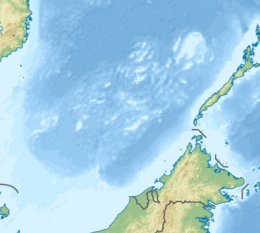| Disputed atoll | |
|---|---|
 Satellite image taken by SkySat in 2020 | |
| Other names | Northwest Investigator Reef 永暑礁 Yǒngshǔ Jiāo (Chinese) Kagitingan Reef (Philippine English) Bahura ng Kagitingan (Filipino) Đá Chữ Thập (Vietnamese) |
| Geography | |
| Location | South China Sea |
| Coordinates | 9°32′57″N 112°53′21″E / 9.54917°N 112.88917°E |
| Archipelago | Spratly Islands |
| Area | 0 ha (0 acres) (Natural) 274 ha (680 acres) (Reclaimed)[1] |
| Administration | |
| Province | Hainan |
| City | Sansha |
| Claimed by | |
Fiery Cross Reef, also known as "Northwest Investigator Reef", Mandarin Chinese: 永暑礁; pinyin: Yǒngshǔ Jiāo; Kagitingan Reef (Filipino: Bahura ng Kagitingan, lit. 'Reef of Valor'); Vietnamese: Đá Chữ Thập, is a militarized reef occupied and controlled by China (PRC) as part of Sansha of Hainan Province[2] and is also claimed by the Republic of China (ROC/Taiwan), the Philippines and Vietnam.
The atoll was named after the British tea clipper Fiery Cross, which was wrecked on the atoll on 4 March 1860. (A later sister ship was also named Fiery Cross). The atoll was surveyed by Lieutenant J. W. Reed of HMS Rifleman, who in 1867 reported it to be one extensive reef, and found the apparent wrecks of Fiery Cross and Meerschaum.[3]
In December 1934 the 'Land and Water Maps Inspection Committee' of the government of the China copied the English name "Fiery Cross Reef" and translated it as 十字火礁 / Shizi huo jiao (literally Fire Cross Reef). This name was published on an official list of names in January 1935.[4] In 1947, it was renamed "Yongshu Reef" (永暑礁) by the government. At that time, Chinese fishermen called it "Tuwu" (土戊).
The atoll was occupied by China (PRC) in early 1988, despite immediate opposition from Vietnam, which led to armed conflict at Johnson Reef South in March of that year.[5] In 2014, the PRC commenced reclamation activity in the area, and it has been converted into an artificial island of 274 hectares (677 acres).[1] There were around 200 Chinese troops on the atoll in late 2014,[6] though this number was likely to have increased significantly in 2015 with the addition of support personnel for the new airbase, including a 3,125-meter-long (1.9 mi) runway[7] and associated early warning radar site.
According to the Center for Strategic and International Studies, it is "the most advanced of China's bases" in the South China Sea's disputed areas, with 12 hardened shelters with retractable roofs for mobile missile launchers already completed. It has enough hangars to accommodate 24 combat aircraft and four larger planes[8][9] Fiery Cross Reef has a runway long enough to land a Chinese Xian H-6N bomber; a bomber like this could perform combat operations within 5,600 kilometers (3,500 mi) of the reclaimed reef.[10]
- ^ a b "Fiery Cross Reef". Asia Maritime Transparency Initiative. Center for Strategic and International Studies. Retrieved 9 May 2018.
Older page showing earlier pictures:
"Fiery Cross reef tracker" (in Chinese). Center for Strategic and International Studies. Archived from the original on 2015-05-29. Retrieved 2016-03-05. - ^ Joe Burgess (1981-05-31). "Territorial Claims in South China Sea". The New York Times. Retrieved 2012-07-25.
- ^ Findlay, Alexander George (1878). A Directory for the Navigation of the Indian Archipelago, China, and Japan (2nd ed.). London: Richard Holmes Laurie. p. 625.
- ^ Hayton, Bill (2019). "The Modern Origins of China's South China Sea Claims: Maps, Misunderstandings, and the Maritime Geobody". Modern China. 45 (2): 127–170. doi:10.1177/0097700418771678. S2CID 150132870.
- ^ Koo, Min Gyo (6 May 2010). Island Disputes and Maritime Regime Building in East Asia: Between a Rock and a Hard Place. Springer Science & Business Media. p. 154. ISBN 978-1441962232. Retrieved 29 March 2017.
- ^ DJ Sta. Ana (13 June 2014). "China reclaiming land in 5 reefs?". The Philippine Star. Retrieved 11 September 2014 – via ABS-CBNnews.com.
- ^ "China completes runway on Fiery Cross Reef". janes.com. Retrieved 28 September 2015.
- ^ "China's Big Three Near Completion". csis.org. Asia Maritime Transparency Initiative (AMTI). Retrieved 29 August 2017.
- ^ Center for Strategic & International Studies (29 July 2015). "China's Airpower from Fiery Cross Reef". Retrieved 29 August 2017 – via YouTube.
- ^ "Airpower in the South China Sea".
